Disclosure: Thank you for reading our articles! Some links may be affiliate links. We may get paid if you buy something or take an action after clicking one of these links. Additionally, as an Amazon Associate, I earn from qualifying purchases.
Oysters are one of those foods that fall into the love-hate category.
Some people absolutely adore their texture and flavor, while others regard them as being slimy and overly salty.
There doesn’t seem to be much middle ground and you’d find it difficult to find somebody who feels indifferent about them.
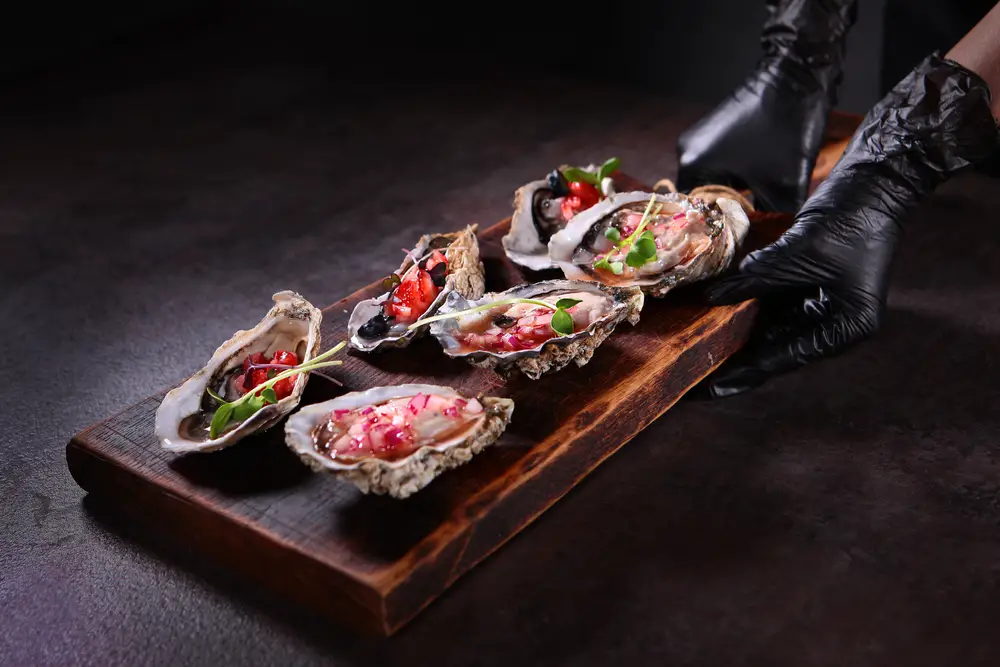
If you fall into the oyster-lover category, one thing that you might not realize is that there are actually several species of oysters, and some of these are broken down into multiple varieties.
What’s more, each of these has its own unique characteristics and flavors.
In this article, we’ll explore each of the different types of oysters in more detail. We’ll look at their natural habitat, what they look like, and, most importantly, what each of them tastes like.
We’ll also take a look at some of the health benefits associated with eating oysters, (giving you even more reason to love them!), how to choose the freshest oysters possible, and how to prepare them.
How Many Types of Oysters are There?
Before we start learning about all the different species and varieties of oysters, let’s look at how many types of oysters there are. The simplest answer to this question is that there are four common species of oysters. These are:
- Atlantic Oysters (Eastern Oysters)
- European Flat Oysters
- Olympia Oysters
- Pacific Oysters
If we look a little deeper, however, each of these four species offers a different oyster variety. For example, the world-famous Blue Point Oysters are a variety of Atlantic Oysters.
One thing you’ll also notice about each species and variety is that, in general, oysters are named after their place of origin.
Each species of oyster also has a slightly different taste depending on where it originated from.
Oysters found in the Pacific Northwest tend to have milder, sweet flavors and crisper flesh. While oysters from California have a stronger flavor.
Some varieties of oyster may even have hints of fruit and vegetables including melon, lettuce, and celery.
Below, you will find a list of some of the most common and beloved oyster species and varieties available.
Pacific Oysters (Crassostrea gigas)
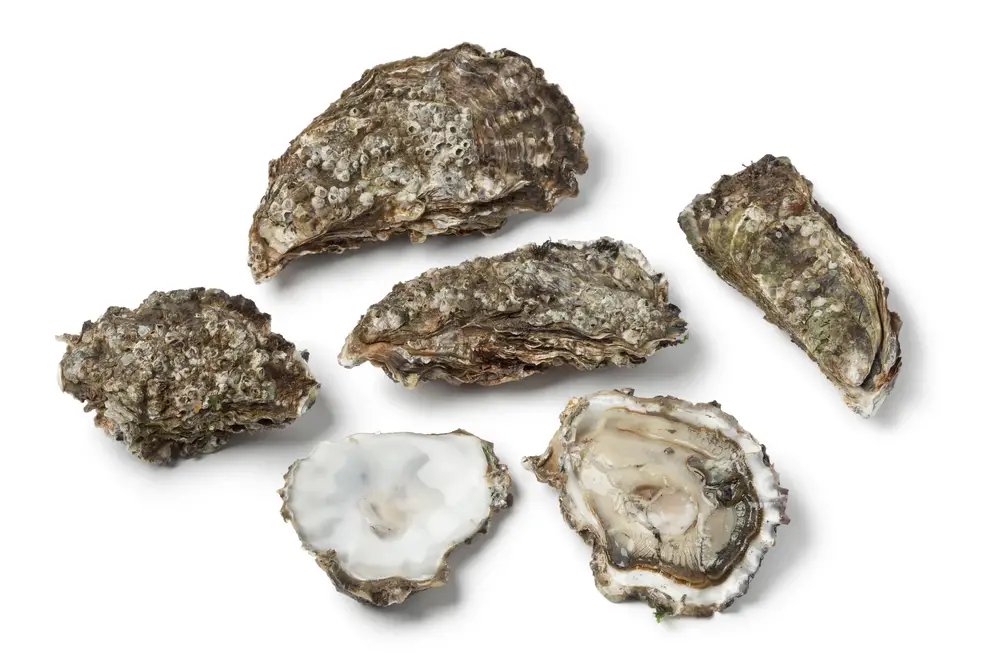
Pacific Oysters go by a couple of different names including Miyagi Oysters and Japanese Oysters. They are considered as one of the most common types of oysters and this is most likely due to the fact that they were introduced to a variety of different countries for aquaculture purposes.
While Pacific Oysters are commonly cultivated on the United States’ Pacific Coast, they aren’t actually native to that region.
In actual fact, they originated from the Pacific Coast of Asia, but they are now cultivated globally in locations including Europe, New Zealand, North America, and Australia.
Pacific Oysters can be found forming in dense mats on rocks as well as softer substrates in sub-tidal zones. They are quite easy to identify as they have a beautiful, blue-grey shell with highly fluted edges.
Once shucked, the inside of the shell is pure white and coupled with a deep purple muscle scar.
Pacific Oysters also grow incredibly quickly and within 2-4 years they can reach between 10-15cm in size.
This is one of the reasons they are such a popular choice for restaurants and fish counters. They provide a quick turnaround time and grow big!
The flavor of pacific Oysters is most often described as a creamy, salty, melon-like taste.
They are also a little sweeter than Atlantic Oysters and, although there are a few different varieties that fall into this category, they all tend to stick to the sweeter side of the flavor spectrum.
Kumamoto Oysters (Crassostrea sikamea)
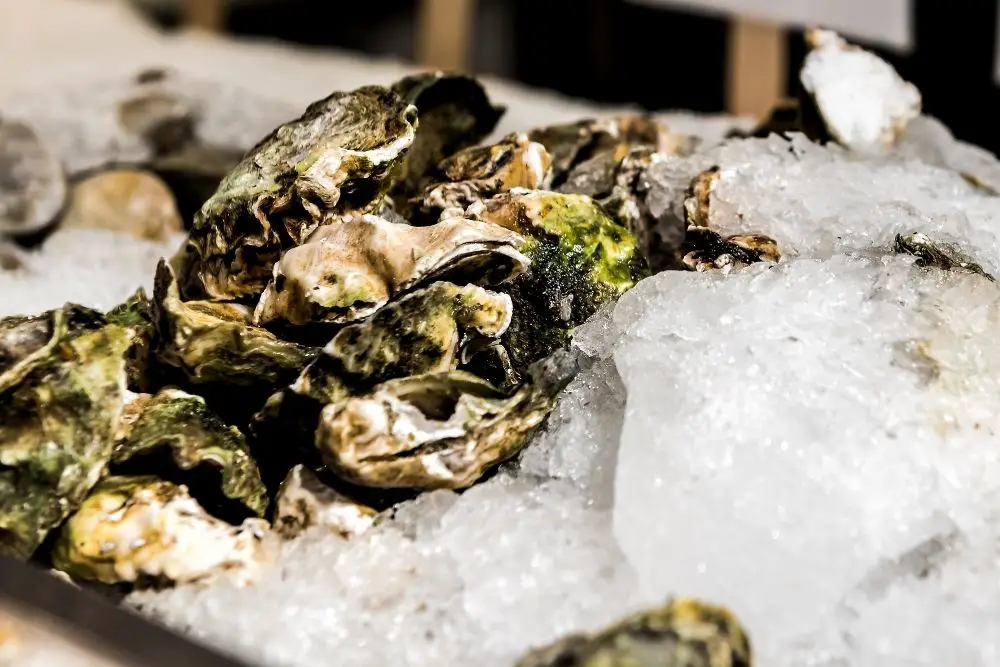
Kumamoto Oysters were once considered as a sub-species of Pacific Oysters, but they have since gained their own species label.
Named after the place of their origin in Japan, they could once only be found in Southern China, Taiwan, and Korea.
However, they are now popularly cultivated in the Pacific Northwest and the West Coast of North America, but they don’t thrive quite as well as they prefer the warmer waters of their native Japan.
They have an irregular shape and unequal valves that make them quite similar to other varieties of oyster. However, they are generally much smaller in size and will usually reach a size limit of just 60mm.
Their shells are round and green in color, and they have a creamy, briny flavor with a melon-like finish.
This flavor has seen Kumamoto Oysters occasionally being referred to as the “Chardonnay of Oysters” by seafood connoisseurs.
They also bear the nickname “Kumies”, which was bestowed upon them over the years by people who fell in love with their tiny size and big flavor.
Belon Oysters (Ostrea edulis)
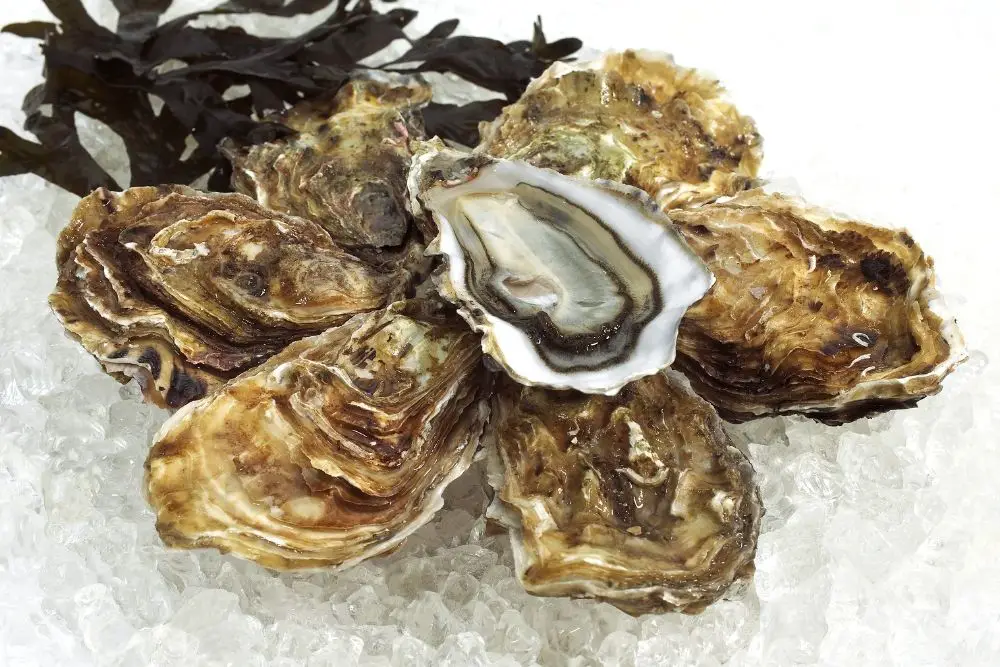
Belon Oysters are a part of the European Flat Oyster species, and, as you may have guessed, they originated in Europe.
In fact, it’s believed that their name comes from the Belon River estuary in Brittany. They also have quite an interesting history behind them.
During the 1950s, it’s reported that scientists transported a Belon Oyster seed from the Netherlands to Maine, hoping to cultivate the species in North America.
However, they soon gave up any hope of this working as they couldn’t see any results after a couple of years of monitoring their growth.
Skip forward ten years later, and the Belon Oysters were found growing rapidly in a variety of Maine’s riverbeds.
By the 1980s, they could be found in huge numbers and they had even found their way into the Damariscotta River.
One thing that separates Belon Oyster from most other varieties is that they have incredibly round, flat shells and less defined cups.
This is one of the reasons they are known as European Flat Oysters, and they also carry the nickname “plates” as they look like small saucers.
Belon Oyster meat is brown in color, and it has a creamy texture with a well-pronounced metallic flavor.
It also has a slightly coppery finish and is sweeter than it is briny. Once cooked, their meat turns from brown to ivory.
Olympia Oysters (Ostrea lurida/conchaphila)
Named after Olympia, Washington, these oysters are believed to have originated in the North Pacific Coast of North America.
They can also be found on the West Coast of Canada, where they are thought to be the only native species.
Other names for Olympia Oysters include “Native Oyster”, “California Oyster”, and “Rock Oyster”, each of which you’ll commonly find being used as a cocktail oyster all over the world.
Olympia Oysters are quite similar to another species of oyster (Ostrea Conchaphila) and they were once considered as two separate species. However, in 1985, researchers carried out an analysis of each and compared their DNA.
In the end, it was concluded that they were, in fact, two different types of oysters.
There can be quite a difference in both the color and shape of an Olympia Oyster’s shell.
Some are elongated while others are much more rounded, and some can be a purplish-black color while others might be white with brown or yellow stripes.
The flesh can also either be white or olive green in color.
Despite their differences in shape and color, all Olympia Oysters have one thing in common; they are the smallest of all oyster species.
On average, they’ll grow no larger than 24mm in diameter, and this is one of the reasons why they’re commonly used as cocktail oysters.
Don’t be fooled by their small size, though. Olympia Oysters are packed with flavor notes of copper, celery, and they have a long-lasting metallic finish. They also have a beautiful, creamy texture.
Sydney Rock Oysters (Saccostrea glomerata)
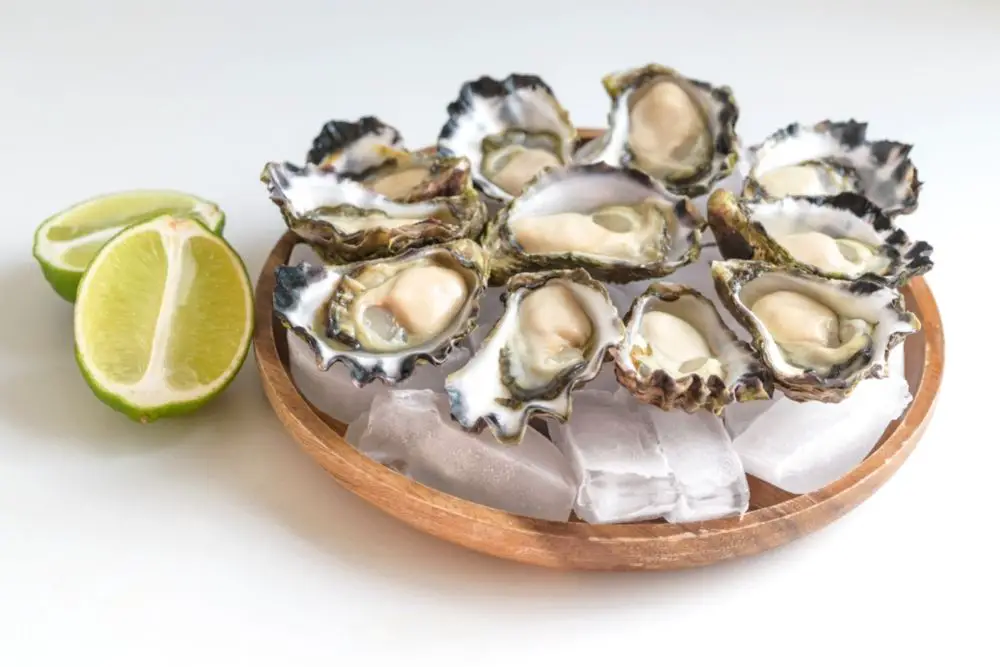
Native to both New Zealand and Australia, Sydney Rock Oysters are also known as “Auckland Oysters” and “New Zealand Oysters”.
Their natural habitats are quite varied and include sheltered bays and estuaries from Victoria to Queensland.
Generally speaking. Sydney Rock Oysters are smaller than most other oyster varieties and they can grow between 6cm-8cm. They have a thick, smooth shell that has tiny teeth lining the internal rim.
They also have a pale muscle scar and the cups are deep, much like that of a Kumamoto Oyster.
As with all oysters, it’s best to eat a Sydney Rock Oyster as soon as it’s shucked, but they can live up to 14 days after shucking if handled correctly. They have a metallic flavor that is less salty than some other varieties and a creamy texture.
Atlantic Oysters (Crassostrea virginica)
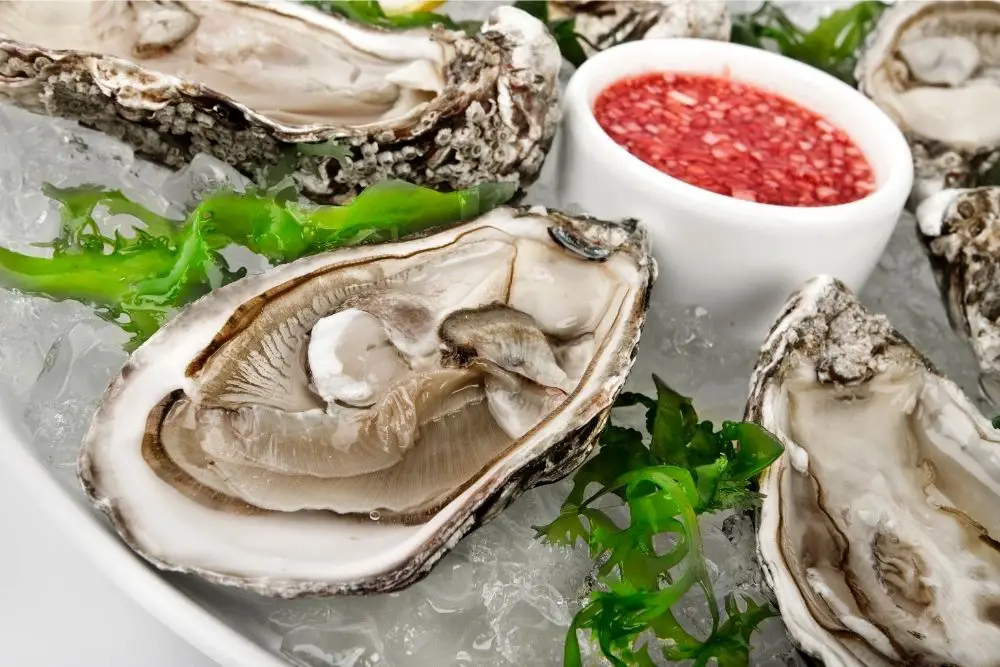
These are found in huge numbers along the North American Atlantic Coast and, as such, they have gained the title of “The American Oyster”.
They are also one of just a few indigenous oysters that can be found in North America, making them that extra bit special!
Around 85% of the world’s Atlantic Oysters are harvested from the United States, while the remaining 15% come from the Gulf of Mexico.
They are also the “state shellfish” of Connecticut, Mississippi, and Virginia.
Atlantic Oysters are one of the largest species of oysters.
They can grow up to 10cm in length and have a gray, pear-shaped shell with a white exterior and deep purple muscle scar. However, depending on the variety, shape, size, and color can vary.
They have a briny, slightly metallic flavor with a savory finish and a crisp texture.
This has made them one of the most popular oyster species on the market, and they are a great choice for anybody who’s curious about oysters but wants to start with a manageable flavor.
Varieties of Atlantic Oysters
The Atlantic Oyster species has a few different varieties, most of which are usually found in Canada and the United States.
Below, we’ll take a look at some of the most popular varieties of Atlantic Oysters, along with their unique characteristics.
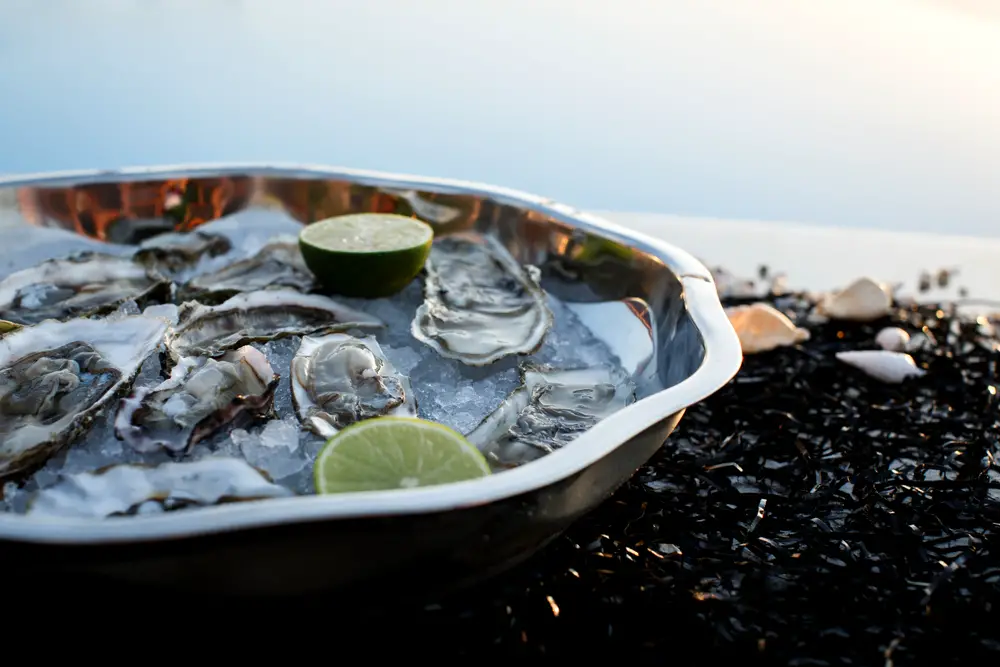
Blue Point Oysters
Although they are named after Blue Point in Long Island, these oysters can be found along the East Coast of the United States in multiple locations including New York, New Jersey, and Connecticut.
They rose to fame back in the 1800s for their crisp texture and robust, briny flavor that has a salty-sweet aftertaste.
Eventually, they were brought over to England where they became one of Queen Victoria’s favorite foods. To this day, they continue to be one of the most popular varieties of oysters in the world.
Beausoleil Oysters
The name “Beausoleil'' translates to “beautiful sun” in English, and it’s easy to see why these oysters gained that name with their crescent-like, light-colored shells.
They are medium-sized oysters that grow to an average of 2.5-inches. They also have a delicate flavor that is mildly salty and that has a sweet finish.
One interesting fact about Beausoleil Oysters is that they are farmed using the suspension tray method.
This makes them rustle together as the waves crash into them and the tide goes in and out, and it’s this constant rustling that produces hard shells with deep cups.
Misty Point Oysters
Most commonly grown on the islands located at the southern tip of the eastern shore of Virginia, Misty Point Oysters are available all year round which means you’ll likely find them in a seafood restaurant or fish counter.
They can grow up to 3-inches in length and their meat is set deep into their cups. Once shucked, these oysters have a strong, salty flavor along with hints of fresh lettuce and celery.
Misty Point Oysters are most commonly cultivated using the tumbling method. This helps harden their shells and ensures a consistent shape with a deep, prominent cup.
Well Fleet Oysters
Well Fleet Oysters thrive in the rich, cold waters of Northern Main and the Canadian Maritime provinces.
The low temperatures of the water actually helps them develop their sweet flavor too, as it slows down their metabolism and builds up their glycogen reserves.
Their meat is plump and has a firm, crisp texture. They also have a high level of brininess which some people find a little jarring but, as is the case with all oysters, other people love.
Malpeque Oysters
These are one of the most popular oysters in all of Canada and they are grown in Malpeque Bay, Prince Edward Island. They have a delicious, tender flavor that lends itself well to anybody trying oysters for the first time.
Their meat is also very succulent and, as the cold Canadian winters come round, a Malpeque Oyster’s adductor muscle gets stronger in a bid to hold the shell together and this creates even more succulence.
Another reason why Malpeque Oysters are so popular is that they are fairly affordable.
If you’re looking to throw a lavish dinner party (or you simply want to treat yourself to a delicious seafood platter) Malpeque Oysters are definitely the type you should consider.
Apalachicola Oysters
There are two different things that need to be discussed as far as Apalachicola Oysters are concerned.
First of all, let’s look at them as food. They are found in the wild and their natural habitat of Apalachicola, which is just off the panhandle of Florida.
They have plump, fat flesh and rich, sweet flavor that has gained them a reputation as being one of the best oysters in the world. However, this has led to their scarcity and they are incredibly hard to find outside of the local area.
This scarcity also leads us to our second point about Apalachicola Oysters.
In September 2012, the Governor of Florida was notified by the Florida Department of Agriculture and Consumer Services that the rate at which Apalachicola Oysters were being harvested from their natural habitat was “a situation quickly becoming a crisis”.
This included an increase in drought conditions and an off-balance of fresh and saltwater.
Because of these environmental factors, The Florida Fish and Wildlife Conservation Commission approved a five-year ban on harvesting wild Apalachicola Oysters and the iconic Apalachicola Oyster Fishery was closed as a result.
For these reasons, you’ll find it difficult to locate Apalachicola Oysters outside of the State and you’d be highly unlikely to find them listed on a restaurant menu.
Health Benefits of Oysters
Oysters aren’t only delicious; they are packed with nutrients that can feed our bodies and help reduce the risk of developing certain diseases.
Here are just a few of the health benefits you’ll be getting the next time you enjoy a plate of oysters:
- Reducing levels of bad cholesterol in your blood
- Boosting the immune system and making it easier to fight off infections, as well as speeding up the healing process
- Feeding your muscles with protein that helps them grow and repair
- Increasing bone mineral density and durability
- Increasing blood circulation with the formation of red blood cells
You don’t need to be eating huge amounts of oysters to get these health benefits, either.
Believe it or not, just 100g of oysters will give your body a good hit of vitamins and minerals and provide you with the following amount of your RDA (Recommended Dietary Allowance):
- Energy: 81 Kcal
- Carbohydrates: 4.9g
- Protein: 9.4g
- Total Fat: 2.3g
- Vitamin C: 13%
- Vitamin B12: 267%
- Riboflavin: 14%
- Niacin: 10%
- Iron: 28%
- Zinc: 111%
- Copper: 79%
- Manganese: 32%
So, even if you’re not a huge fan of oysters, there’s no denying that eating a few from time to time will help improve your health and keep you fighting fit!
How to Pick Fresh Oysters
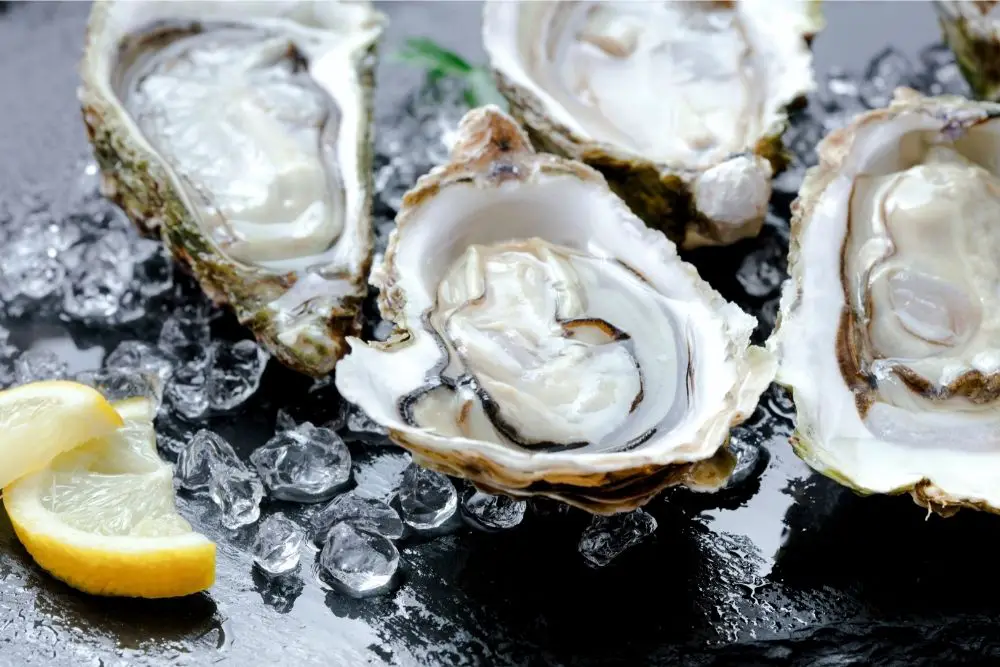
By now, you’re probably eager to make the journey to your local seafood specialist and see which of the above types of oysters they have to offer.
But, as with all food, it’s important to make sure you’re choosing the freshest oysters possible.
We’ll take a look at what to look for when choosing your oysters in a moment, but, before we do, let’s get one thing out of the way.
There is an old saying when it comes to choosing oysters; “only eat oysters in the months that have the letter R in them”.
But is this true? Can you only eat oysters between September and April? And, if so, why is National Oyster Day on August 5th?
Allow us to clear this up once and for all. While oysters have a natural spawning cycle that would ordinarily stop you from eating them in the wild, oysters are now farmed all year round.
As such, they are available all year round and, you guessed it, they can be eaten all year round, too.
There is, of course, some accountability for the way that oysters are farmed which includes monitoring the water for bacterial imbalances and temperature changes.
But, for the most part, this doesn’t stop them from being available throughout the year.
It’s a simple rule to follow, really. If you’re eating wild oysters, follow the “R rule”. If you’re eating farmed oysters, you can enjoy them at any time of year.
Now that the confusion around that has been sorted out, let’s take a look at what you should be paying attention to when choosing fresh oysters.
Look
The first thing you should do is give them a good inspection simply by looking at them.
If the shell is sealed tightly shut, you’ve got a good oyster. If there is a small gap and the shell isn’t entirely closed, give it a gentle tap to see if it closes.
If it does, it’s a good one. If it doesn’t, the oyster isn’t fresh and you should move on to the next.
Smell
Another way to check that your oysters are fresh is to smell them. A good oyster will smell like the sea, while one that has gone slightly past its best will have a pungent, fishy smell. Put simply, if it smells bad, don’t buy it.
Feel
Finally, a fresh oyster will feel heavier than one that was harvested a few days ago. The reason for this is that a freshly harvested oyster will still be holding onto seawater.
This seawater is also what gives the oyster its unique flavor, so the heavier it is, the fresher it will be and the more delicate it will taste!
How to Store Oysters
It’s always best to buy your oysters on the same day that you’re planning on eating them.
Doing this means you’ll have the freshest oysters possible and, ultimately, means that you’re not risking food poisoning by accidentally eating an oyster that’s gone bad.
This doesn’t mean that you can’t buy them a couple of days in advance, though. You just need to make sure you’re storing them properly. This is absolutely crucial for keeping them fresh until you eat them.
The best way to store oysters is to simply keep them in your refrigerator. Place them in an open container and lay a towel on top of them that has been soaked in the coldest water possible.
It’s also very important to note that you should always store your oysters with the rounded side pointing down.
This ensures that the seawater contained inside the shell stays where it is and that your oysters will have that delicious flavor.
How to Clean Oysters
First of all, don’t try and get ahead of the game by prepping your oysters. They need to be cleaned as close to when you want to eat them as possible. With this in mind, here’s what you need to do to clean your oysters.
Right before you’re ready to eat, fill a small bowl with ice-cold water and place your oysters inside.
Let them sit there for 10 minutes. You’ll soon notice sand, grit, and small pieces of debris sinking to the bottom of the bowl.
Once the ten minutes have passed, remove the oysters from the bowl and throw away the water.
Now, take a hard-bristled brush and scrub the outside of the oyster. This will remove any remaining debris, sand, and dirt and make sure that the shells are perfectly clean.
That’s all there is to it! Cleaning oysters is a simple but incredibly important step in preparing them to eat.
How to Shuck Oysters
As you can see from the steps we’ve listed above, cleaning oysters is really easy.
However, when it comes to opening that tightly sealed shell to get to the meat, many people are put off by how difficult it looks. This isn’t necessarily the case, though!
All you need to shuck oysters is a few simple tools. Here’s what you need to do:
- Put on some oyster shucking gloves. These will protect your hands from the knife if it accidentally slips, which may be likely if you’ve never shucked an oyster before.
- Once you’ve put on your oyster shucking gloves, grab your oyster shucking knife. Use your dominant hand to hold the knife as you’ll need to be able to control it well.
- Next, take an oyster and hold it in the palm of your hand with the rounded side facing down.
- The oyster’s shell is being held together by a small hinge at the back. Locate this hinge and carefully insert your oyster shucking knife into it or directly next to it. Once you’ve done this, twist the knife in a clockwise direction while lifting it slightly. This should cause the hinge to pop open.
- Once the hinge is open, carefully glide your knife down the middle of the shell. This will release the oyster from the top of the shell as well as allowing it to open fully. This is an especially important step if you’re serving your oysters raw, as you’ll need the meat to be separated from the shell for easier eating.
It’s really that simple! Once you’re done, you can lift the top of the shell off and you’ll see your beautiful oyster.
You’ll also know exactly what to do next time you need to prepare oysters and you’ll be able to do it with complete confidence.
When you’re shucking oysters, it’s really important that you don’t lose any of that precious seawater in the process.
It’s also important to make sure that you don’t accidentally get any pieces of chipped shell onto the oyster meat.
Following each of the steps we’ve listed above should prevent you from doing either of these things.
Oyster Facts
As you can see, there are loads of different types of oysters available and each is as delicious as the last.
There are also multiple health benefits associated with eating them. But did you know that oysters have been used in other ways as well?
Between 1880 and 1910, the United States began producing around 160 million pounds of oysters every year.
This number far exceeded the oyster production number of every other country combined and the consumption of oysters rose so high at one point that New York City’s ‘Pearl Street’ was actually paved using oyster shells.
They were even used as part of the foundations in several buildings that still remain standing to this day.
Oysters are also fantastic for the environment. One single oyster is capable of filtering up to 50 gallons of water each day.
They do this as they suck water through their gills in an attempt to capture their primary source of prey, which is plankton.
As they do this, any pollution in the water is processed and clean water is created.
Conclusion
So, there you have it, everything you need to know about the most popular and some of the rarest oysters in the world.
If you’re not already familiar with the unique flavors each has to offer, we’re pretty certain that you’ll be more than eager to start trying as many of them as possible.
Likewise, if you’ve never tried oysters before or you’ve had a bad experience, you now know there are many different types of oysters and lots of different flavors outside of what you originally thought. You might even find one that pulls you over to the oyster lover’s team!
As you work your way through each of these oyster varieties, the one piece of advice we would offer is to make sure that you’re choosing the freshest oysters possible.
Follow the steps we’ve listed above to check their appearance, weight, and smell. And, once you’ve found that perfect oyster, eat it as soon as possible to enjoy its incredible flavor.
